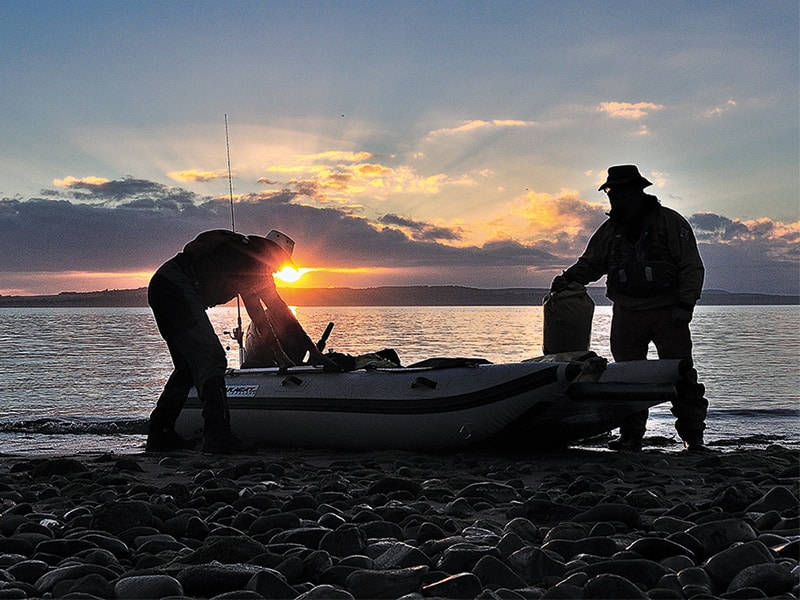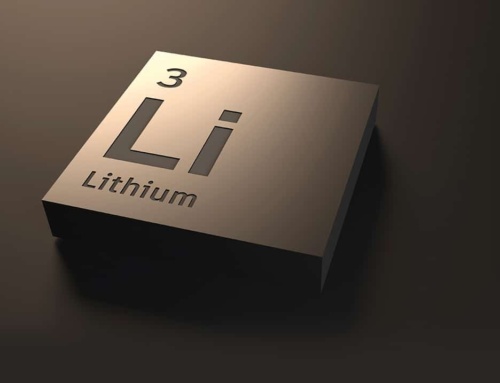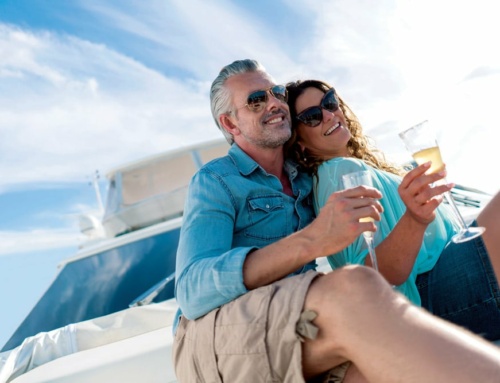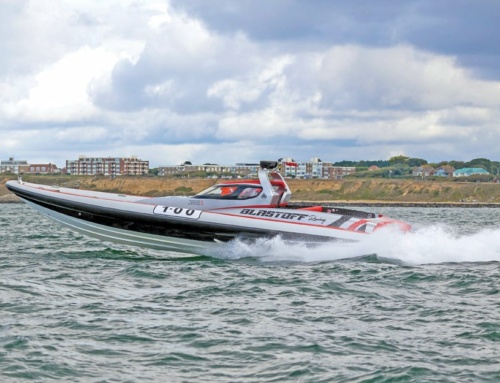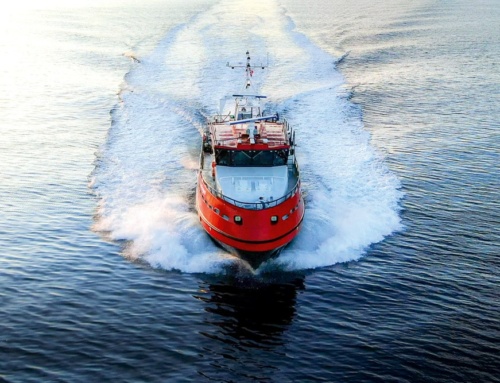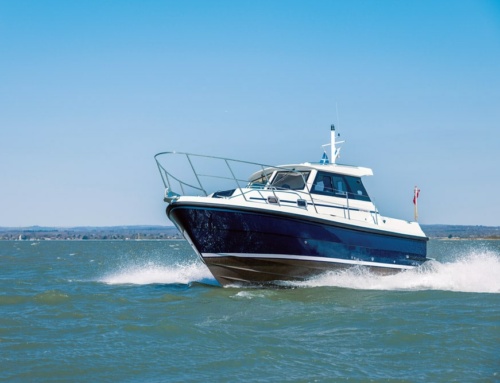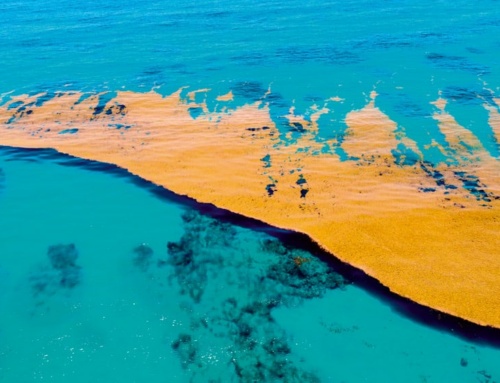With just a tarp and a sleeping bag each, and a soft inflatable dinghy, Simon Everett and his friend Paul Fennell set out on a three day wild camping adventure.
You have to love the outdoors, really love it, to forgo any kind of luxury through choice. Both Paul and I are quite happy to sleep under the stars and take our chances with the weather. A tarp overhead keeps the rain off, sand beneath forms our mattress and on this trip we had the added bonus of the boat to provide a decent barrier against the wind.
It might sound incredulous to those readers with a motor cruiser at their disposal, but there is an upsurge in interest for this kind of simple, low cost boating, especially when it can provide a real taste of adventure on a low budget. The lightweight inflatable, outboard motor, two tanks of gas, propane to be precise, together with our camping kit and fishing gear all fitted into the boot of my Golf estate. Had we needed to, the boat could have been inflated and carried on the roof of the car. It is a viable option as the entire boat only weighs about 50kgs inflated and most car roof racks are rated to 100kgs.
Our plan was to explore some of the Clyde, there are various options depending on weather and fuel range. This was our first venture with the rig and we had no idea how far or how long a gas bottle would last us. Manufacturers figures are all very well in the perfect world of a test tank, but out on the sea, in a less than perfectly set up boat, loaded to suit us rather than the best hydrodynamics one needs to be pessimistic, so we erred on the side of caution and stayed well within range. It didn’t detract from our enjoyment one little bit.
One of the beauties of a lightweight, inflatable is that the tide is less dictatorial, having the water in is more convenient, but with built in, retractable, launching wheels and being light enough for the two of us to carry anyway one is freed from the tidal constraints that keels create. The tide was on the ebb, but still well up the Largs slipway so it was going to be an easy launch in the late afternoon sunlight.
Taking everything out of the car and being able to spread ourselves out a bit helped in the set up. From arrival to having the boat ready to go took less than 30 minutes, the Takacat really is simple to put together, it would be faster the second time of asking too. The inflatable deck just slides in and then the tubes pumped to full pressure once it is in place. The thwarts could do with a better means of fixing. The Velcro straps are too wide for the D rings used, so there was a bit of ambiguity about their placement. It is an easy fix at the factory end though and not a deal breaker. Other than that everything fitted together very accurately and tightly. The transom plate went straight on with the bolt holes aligning with the mounting frame perfectly.
We had the Lehr 9.9hp outboard, which is the largest the boat is rated for. It took it, but I felt this engine was a little heavy for the boat and a 6hp would be better overall. The propane bottles do take up a fair bit of room and I remarked to Paul that if it were mine I would have a petrol engine with bladder tanks to save as much space as possible.
The benefit of the gas fired outboard is the complete lack of smell, the complete removal of any possible pollution through spillage and it is impossible to flood the motor. Apart from the environmental considerations propane is a very affordable fuel and being able to share the gas cylinders with the barbeque saves storage space at home. They are simply exchanged at Homebase for a new one. The 10lb bottle, oddly enough they are sold in Imperial units, is meant to give 7 hours running at 3000rpm. The only trouble was, we didn’t have a tacho, so we would have to go by ear and throttle position! I reasoned that 3000rpm was roughly 2/3rds revs and so easy enough to judge.
With everything loaded we set off, heading northwest for the northern end of Great Cumbrae island. It was late afternoon and the sun was already on its descent for the horizon and we had to find somewhere to make camp yet and procure something for supper! We had brought some simple fishing gear with us, with the intention of catching some mackerel to cook. We hoped!
Running across the channel between Largs and Cumbrae is only a couple of miles, at most. We didn’t rush, getting the weight distribution right to gain the best running attitude took a bit of trial and error and so it took us longer than it might have done had we been more familiar with the boat. At least we now knew a bit more about what this inflatable catamaran was like and how she responded to load placement, with a care for leaving room for my legs in the aft section. Paul had loads of space around the forward thwart, despite all the cargo and the rods were happily housed out of the way in the dedicated rod holders aft.
We motored easily across the channel to the northern end of Great Cumbrae and on around to the north west tip, where a distinct current line could be seen, this is usually a good sign for fishing, so we decided to try and catch some tucker. It didn’t take long, the mackerel were fairly easy to catch and within 10 minutes we had a brace each for supper. Now it was important we found a safe place to land and set up camp.
We didn’t have to go far, we motored gently down the shoreline keeping a weather eye open for underwater obstructions even though the Takacat only needed a foot of water. About a mile down the western shore we found a gently sloping sand and shingle beach with the offer of some shelter behind a rocky outcrop well above the tide line, judging by the line of seaweed. It was exactly what we needed and proved ideal with the rocks forming two sides of the bivvi shelter, the boat forming the bottom and the fire pit off to the open side.
Finding fire wood wasn’t as easy as we had hoped. Normally one can realistically expect there to be some driftwood washed up, but this beach had very little. By searching hard we did gather enough, but we had to work and gather diligently. Not even small twigs were passed up, every little helps. It is important to gather a good stock of fire material before lighting the fire, otherwise there is the danger of losing the fire while you are off searching for more. Make sure you have plenty and organise it ahead of striking up the blast match. It will make keeping the fire in so much easier.
With the fire going beautifully, providing both warmth and a wonderful feel good factor I got the MSR Dragonfly cooker out and started cooking the catch. One of the joys of mackerel is they cook in their own oil. For the first fillets I used about a spoonful of water, straight from the sea, merely to prevent that first fillet from sticking to the pan. Once I had cooked one, there was sufficient oil released from the flesh to cook the remainder. They tasted superb and gave us some much needed warm sustenance. Having cleaned the pot we were then able to make a hot coffee to finish off. The stars seemed extra bright that night as we climbed into our sleeping bags.
The following morning was damp and misty, not actually drizzling but the air was full of moisture and had covered everything in a fine film of wetness! The fire had gone out sometime in the early hours, so the camp cooker was fired up and heat introduced to our bodies. We had brought some easy to cook rations with us, to kick start the day. A boil-in-the-bag all day breakfast and packet of instant porridge oats provide a major portion of the calories required and take up virtually no room.
We loaded all the kit back into the boat and wheeled her down to the water. The plan was to carry on south along the shore of Great Cumbrae and then on around Little Cumbrae, keeping our eyes open for possible camping sites as we went. About half way along the shore we spotted something of interest and couldn’t work out what it was. So we found a tiny, sandy gap in the rocks, no more than 3 or 4 yards wide, but sufficient to get the nimble Takacat into safely. It was very calm and luckily there was no swell to speak of, even so, our beach landing was protected by a rock spur.
With the tide just on the flood, we ran a long line ashore and made it fast, and waded out with the anchor and set that from the stern to prevent the boat from riding in on the tide. Happy the boat was safe, we walked across the rocks and up to the man made structure we had seen from the water. It turned out to be a beautifully kept memorial to the fallen. Facing westwards, the inscription cut out of the metal plate would be illuminated by the setting set. How poignant. We paid our respects and returned to the dinghy to carry on our little adventure.
Passing between the two islands the tidal currents were leaving telltale patterns on the surface and the bird activity was all around us. As we approached the northern edge of Little Cumbrae we could see dozens, maybe scores, of Cormorants sat on the rocky point, digesting their breakfast and drying out. The little boat, moving quietly and gently, didn’t disturb them. They were alert, of course, but allowed us to pass quite close without causing any distress or disturbance to their normal routine. One of the benefits of a small boat is this acceptance by wildlife, making them ideal if you enjoy bird watching and other wildlife.
This end of Little Cumbrae had one possible beach we could land on, it was very steep and faced south west, but it was noted for later, when there would be a better approach at high water in the evening. In our sights now was the castle bay with the old, square tower overlooking the channel between the island and the mainland. There is an easy approach and a sandy landing right in front of the estate boathouse, decorated with the coat of arms for the island estate. On the approach we slid past the seal colony that was basking in the autumn sunshine on the rocks. There is a wonderful house but nobody was home when we called, so we continued around the path and picked some blackberries from the brambles and returned to the boat to carry on around the island.
We were warming to this roomy little inflatable. The twin sponsons and inflated deck make it very stable and far roomier than a conventional, pointy bow inflatable of the same length. In typical catamaran fashion it also coped with waves without throwing water all over us. When she did dip her nose, going over the wash from a tug, water lopped over the bow and just ran straight out the stern. Provided you keep your gear in a waterproof bag there is no problem – and don’t forget we were very heavily loaded.
The bottom end of Little Cumbrae is very rocky and the lowland turns to cliffs. Half way along the western shore there is an abandoned lighthouse. The purpose built harbour is still there, with a small breakwater and jetty built onto the sides of a natural gully. The boathouse still stands, and the railway lines for the launching trolley down the slipway are still present, but twisted and bent. Exploring the walled garden of the lighthouse and keepers’ cottages was like stepping back in time. The original switch gear was still present, complete with bakelight switches and it is a long time since I saw a toploading, Servis washing machine with an integral mangle. There were two of them still there!
The house is open and has been used as a bothy for campers, but it was not very appealing, being damp and left dirty by previous visitors. There are still remnants of old furniture and in one room a couple of sets of seats from an aeroplane, of all things. We didn’t fancy hauling our gear the 300 feet up the slippery cliff steps either. We considered staying on the lower levels but decided, with the weather closing in and the wind increasing from the southwest, our previous campsite was the better bet, so decided to return there for the night again.
On the way we did have a look at the little beach on the northern end of the island, the one we had seen in the morning. It was too exposed to the southwest for us to contemplate setting up camp, and the beach was very steep to haul the boat up. However, we were glad we had landed because there was plenty of driftwood washed up, so we collected armfuls and loaded the boat up to ensure we could have a decent fire, one that would go right through the night, it was going to be wet and windy and every ounce of comfort would be welcome.
With firewood collected we set about catching supper again. The tidal confusion between the two islands was where we dropped our Sabikis and almost immediately the rods hooped over as mackerel snatached at our hooks. To make life easier on board we had cut one set down and had half each, this limits the number of hooks and makes managing the slithery, struggling melee much easier and tangles less likely, to say nothing of the safety aspect. Within a few minutes we had enough fish to feed ourselves like fighting cocks and headed north for our beach.
With the benefit of a practise the night before our bivvi was created quickly and easily with a better deployment to keep the weather that was coming in off us. We broke the firewood up into usable lengths and piled it neatly near the fire ready to be added as needed. Only then did I make a pyramid of smaller twigs and easily lit material, using a cotton wool ball that had petroleum jelly rubbed into it as a firelighter. My BlastMatch is a self contained fire steel that produces a mass of hot sparks and can be relied upon to create ignition. We soon had a really good fire going within the rock wall built around it. Like before, the mackerel was filleted and cooked in its own oil, skin side down, until slightly crispy. Straight out of the sea there is nothing better, especially after a long day on the water.
True to form, the weather set in and we had persistent rain and strong wind all night. Our tarp kept the weather out though and the fire threw warmth that we could feel from within the folds of our sleeping bags. It wasn’t the most comfortable night I have had, but roughing it adds to the adventure and makes one appreciate normal life. Getting back to nature and exploring in a small boat gives one a real experience of the outdoors, people pay a fortune to do this with the likes of Ray Mears you know, when in fact, you can do it yourself for next to nothing.
The Takacat was an ideal tool for the job and I look forward to another trip, but we would use a lighter, petrol powered outboard and if bladder tanks were available it would free up a lot of space. The seakeeping was a revelation, the following morning we had a proper sea to contend with as it had been blowing all night and the force 5 had whipped up a nasty sea in the mouth of the Clyde. The Takacat rode it with ease without us having to ease off the throttle even.
Upon reaching the slipway where the car awaited the tide was right out, the shallow draft and light weight meant all we had to do was put the wheels down and pull the little boat ashore and up the slipway. Within half an hour everything was packed in the boot and we were on our way home. It just goes to show, you can enjoy wild places, wildlife and the sea for under £3000. It was good to get a touch of reality again.

